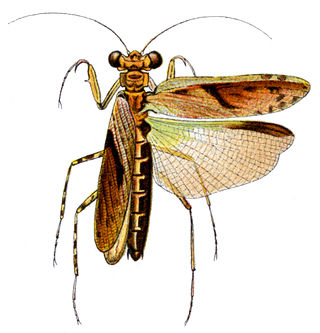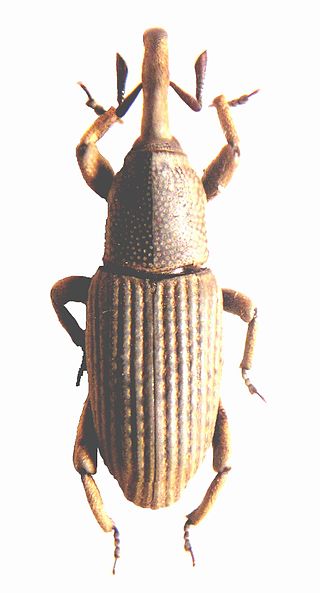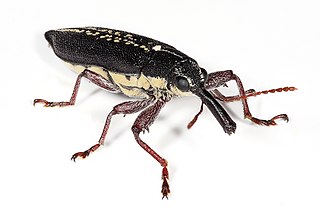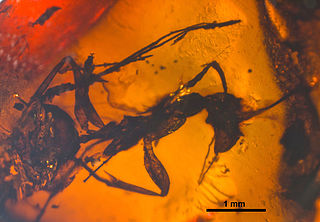
Chaeteessidae is a family of praying mantises. It contains a single extant genus, Chaeteessa, native to South America which is thought to be the most primitive and earliest diverging lineage of living mantises. Fossil genera are known from the Paleogene of Eurasia and North America.

Amorphoscelidae is a family of mantises in the order Mantodea.

The insect tribe Stromboscerini is part of the weevil family Curculionidae, subfamily Dryophthorinae. It is a small and little-known weevil group. Alonso-Zarazaga & Lyal (1999) treated it as a subfamily.

Belidae is a family of weevils, called belids or primitive weevils because they have straight antennae, unlike the "true weevils" or Curculionidae which have geniculate (elbowed) antennae. They are sometimes known as "cycad weevils", but this properly refers to a few species from the genera Parallocorynus and Rhopalotria.

Alexandr Pavlovich Rasnitsyn is a Russian entomologist, expert in palaeoentomology, and Honored Scientist of the Russian Federation (2001). His scientific interests are centered on the palaeontology, phylogeny, and taxonomy of hymenopteran insects and insects in general. He has also studied broader biological problems such as evolutionary theory, the principles of phylogenetics, taxonomy, nomenclature, and palaeoecology. He has published over 300 articles and books in several languages. In August 2008 he was awarded the Distinguished Research Medal of the International Society of Hymenopterists.

The Cerophytidae are a family of beetles belonging to Elateroidea. Larvae are associated with rotting wood, on which they are presumed to feed. The family contains over 20 species in five genera, primarily distributed in the New World, but also in Eurasia and Africa. 17 fossil species in 7 genera are known extending to the Early Jurassic. Like some other elateroids, the adults are capable of clicking.

Cryptophagidae is a family of beetles with representatives found in all biogeographic realms. Members of this family are commonly called silken fungus beetles and both adults and larvae appear to feed exclusively on fungi although in a wide variety of habitats and situations, such as rotting wood and shed animal fur and feathers. These beetles vary from about 1 to 11 millimeters long, and usually have an oval body shape with a slight "waist".

Latridiidae is a family of tiny, little-known beetles commonly called minute brown scavenger beetles or fungus beetles. The number of described species currently stands at around 1050 in 29 genera but the number of species is undoubtedly much higher than this and increases each time a new estimate is made.

Nemonychidae is a small family of weevils, placed within the primitive weevil group because they have straight rather than geniculate (elbowed) antennae. They are often called pine flower weevils. As in the Anthribidae, the labrum appears as a separate segment to the clypeus, and the maxillary palps are long and projecting. Nemonychidae have all ventrites free, while Anthribidae have ventrites 1-4 connate or partially fused. Nemonychidae lack lateral carinae on the pronotum, while these are usually present, though may be short, in Anthribidae.
Slonik is an extinct genus of weevils in the family Brentidae. It is monotypic, being represented by the single species Slonik sibiricus.
Dinopanorpa is an extinct monotypic genus of scorpionfly that contains the single species Dinopanorpa megarche and is the type genus of the extinct family Dinopanorpidae. The genus is known from a single hindwing specimen, the holotype, currently deposited in the collections of the National Museum of Natural History, as number "69173", and which was first described by Dr Theodore D.A. Cockerell in 1924. The name is a combination of the Greek deino meaning "terrible" or "monstrous" and "Panorpa", the type genus of Panorpidae the family in which Dinopanorpa was first placed.
Vladimir Vasilevich Zherikhin, of the Paleontological Institute, Russian Academy of Sciences, Moscow, was one of the world's leading paleoentomologists and coleopterists. He worked on the palaeontology of the Coleoptera (beetles) and of insects in general, and on the taxonomy of the weevils (Curculionoidea).
Saurodektes is an extinct genus of owenettid procolophonoid parareptile known from the earliest Triassic deposits of Eastern Cape Province, South Africa. It was first named by Sean P. Modesto, Ross J. Damiani, Johann Neveling and Adam M. Yates in 2003 and the type species is Saurodectes rogersorum. The generic name Saurodectes was preoccupied by the generic name of Saurodectes vrsanskyi Rasnitsyn & Zherikhin, 2000, a fossil chewing lice known from the Early Cretaceous of Russia. Thus, an alternative generic name, Saurodektes, was proposed by Modesto et al. in 2004. The generic name means "lizard", sauros, and "biter", dektes from Greek. The specific name, rogersorum, honors Richard and Jenny Rogers, owners of the farm Barendskraal, for their hospitality, support and interest in the work of the paleontologists who recovered the holotype. Saurodektes is known solely from the holotype BP/1/6025, a partial skull and some fragmentary partial postcranial elements, housed at the Bernard Price Institute for Palaeontological Research, although the unprepared specimens BP/1/6044, BP/1/6045 and BP/1/6047 might also be referable to it. All specimens were collected on the slopes of the Manhaar Hill at Barendskraal in the Middelburg District, from the Palingkloof Member of the Balfour Formation, Beaufort Group, only 12 metres below the base of the Katberg Formation. This horizon belongs to the Lystrosaurus Assemblage Zone, dating to the early Induan stage of the Early Triassic period.

Zherichinius is an extinct genus of ants in the subfamily Dolichoderinae known from fossils found in amber from the Middle Eocene of Sakhalin island Far eastern Russia and Bitterfeld, Germany. At the time of description the species Zherichinius horribilis and Zherichinius rapax were two of eight ant species known from Sakhalin fossils.

Holcorpa is a genus of extinct insects in the scorpionfly order Mecoptera. Two Eocene age species found in Western North America were placed into the genus, H. dillhoffi and H. maculosa.
Leptoconops zherikhini is an extinct species of biting midges belonging to the family Ceratopogonidae. This species was described from fossilized remains preserved in Lower Cretaceous amber from Álava, Spain. These fossils represents the earliest known occurrence of extant genus Leptoconops.

Stenoscelis is a genus of snout and bark beetles in the family Curculionidae. There are at least 30 described species in Stenoscelis.
Trichalophus is a genus of broad-nosed weevils in the beetle family Curculionidae. There are more than 50 described species in Trichalophus.
Baissomantis is an extinct genus of mantises in the family Baissomantidae. There are two described species of Baissomantis both of which are known from the Early Cretaceous Zaza Formation of Buryatia, Russia.
Cretomantidae is an extinct family of mantises in the order Mantodea. It contains at least one genus Cretomantis, which is known from the Early Cretaceous Zaza Formation of Buryatia, Russia. The genus Electromantis known from Late Cretaceous (Santonian) Taimyr amber of Russia was formerly placed in this family, but is currently considered incertae sedis within Mantodea.











